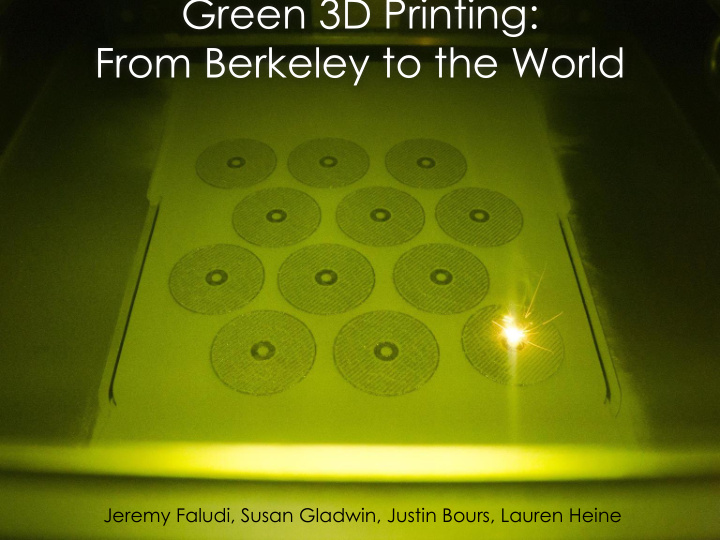



Green 3D Printing: From Berkeley to the World Jeremy Faludi, Susan Gladwin, Justin Bours, Lauren Heine
Jeremy Faludi
Printing Process Variety 3 images from renishaw.com, 3Dsystems.com, stratasys.com, afinia.com, typeamachines.com, engadget.com
3D Printing Myths vs. Facts 4
Myth #1: No Transportation 5
Myth #2: No Waste 6
Energy is Main Impact 7
Is 3D Printing Green? It Depends… 8 images from renishaw.com, 3Dsystems.com, stratasys.com, afinia.com, typeamachines.com, engadget.com
Is 3D Printing Green? It Depends… 9
Utilization 10
Utilization 11
Utilization 12
Obstructing Circular Economy 13
Irreversible Materials 14
Mixing Materials Inseparably 15 image from mit.media.edu
Enabling Circular Economy 16
Efficient Vehicles 17 image from bloomberg.com
Repair 18 Screen shot of thingiverse.com
Democratize Production 19 image from 3dprintingindustry.com
Align Economic Incentives Material use = $ Complexity ≈ free 20
Enable Green Materials? 21 image from mit.edu
22
Susan Gladwin
Biofriendly
The hazards of Stereolithography (SLA) Resins Reproductive toxicant Photoinitiator (0.4%) Eye irritant Reactive Oligomers (79.55%) Skin irritant Reactive Monomer (19.88%) Aquatic toxicant UV-blocker (0.16%) Skin sensitizer
The life cycle for SLA Printing
Ubiquity of 3D Printing Light Industrial. $1,000s+ $100s Industrial. $100,000s+ 2015 Now 1990’s
Open+ Creative Commons: code, CAD, materials recipe
Collaborators
Justin Bours
Greener Solutions Class Methods Explore Identify Evaluate Bio-inspired Alternative New Resin Approaches Resin Materials Materials
Three Tiers of Disruption I. REPLACING THE PHOTOINITIATOR Strategy A: Curcumin & Riboflavin II. MODIFYING ACRYLATE-BASED RESINS Strategy B: Triglycerides Strategy C: Chitosan III. pH PHOTOINITIATED RESINS Strategy D: Calcite Strategy E: Metal Ligand Complexes
Hazard Comparisons
Autodesk + BCGC Collaborative Publication https://onlinelibrary.wiley.com/doi/full/10.1111/jiec.12587
Framework Approach VS Other Analyses ONLY ONLY OUR Lack of Underrepresentation APPROACH life-cycle thinking of direct human health impacts
Curated, stepwise framework development
Defining the life cycle for SLA Printing
Defining the life cycle for SLA Printing Printing Printing Process Print Use Process Waste Disposal Stage Stage Stage Print Disposal Stage
Identify criteria, metrics, methodologies Criteria Metrics Methodology Human Health Profile CHA* QCat, C2C Physical Hazard CHA QCat, C2C Waste, Electricity Post-Processing Green Design, CHA Usage, QCat, GreenScreen QCat, C2C, Volume Ultrafine Particles CHA, RA** of particles QCat, GreenScreen, VoC Emissions CHA, RA Volume of particles Printing Process Stage
PR48 is significantly more hazardous than PLA Human Health Profile of AM Materials Toxicity Endpoint Categories Autodesk PR48 PL A Printing Process Stage
PLA substantially outperforms Autodesk PR48* Autodesk’s PR48 PL A Printing 0 1 Printing Process Process Printing Printing Process 2 0 Process Waste Waste Disposal Disposal 2 1 Print Use Print Use 2 1 Print Disposal Print Disposal Overall 1.75 Overall 0.5 *Comparing materials from similar technologies will likely result in closer ratings
Using framework to identify improved materials/processes Autodesk’s PR48 Printing Using an acrylate resin with 0 1 Process a bio-derived backbone Printing 1 0 Process Waste Disposal 2 1 Print Use 1 1 Print Disposal 1.25 Overall 0.5 Arakawa, Christopher Kenji. “A Novel Photopolymerizable Chitosan Collagen Hydrogel for Bone Tissue Engineering,” 2012. http://escholarship.org/uc/item/1wp7v2g2.pdf.
Autodesk blogs on this work http://blogs.autodesk.com/netfabb/2015/11/18/t owards-sustainable-biofriendly-materials-for- additive-manufacturing-part-1-of-3/
Lauren Heine
3D Printing Roundtable Justin Bours, Lauren Heine, Amelia Nestler, Mark Buczek and Jeremy Faludi Northwest Green Chemistry, Autodesk, Cradle to Cradle Products Innovation Institute Dartmouth College 46
Designing an AM Product Design Scorecard INSIGHT LCA S AM Product Roundtable INSIGHT Design Discussion S Scorecard Publication Framework and INSIGHT Other Research S Printer Materials Printer Design Printer Operations
Participants in the 3D Printing Roundtable Printer/Software Manufacturers NGOs • Autodesk • Northwest Green Chemistry • XYZprinting • Cradle to Cradle Products Innovation Institute • Pollen AM • Ellen MacArthur Foundation • Structo 3D • Green Chemistry and Commerce Council Material Manufacturers Academia • Clariant • Berkeley Center for Green Chemistry • Covestro • University of California Irvine • CPS Polymers • Universidad de Santiago de Chile, Alysia Garmulewicz • Millipore-Sigma • Dartmouth College • NatureWorks Government • SABIC • US EPA • ZilaWorks • WA State Department of Ecology AM Users • Oregon Department of Environmental Quality • Lego Consulting firms/Industry Expertise • Pre Sustainability Consultants 48
Participant Recommendations • An appropriate assessment tool can support decision making for both: • Material selection and • Product design • Results should be simple and visual • There will always be tradeoffs and imperfect information, • Tradeoffs should be transparent • No one assessment tool can provide all of the answers on sustainability; they need to be used together in a systemic way • Life cycle (impact) assessment • Chemical hazard assessment • Exposure assessment • Risk assessment • Circularity Assessment (Sustainable Materials Assessment) 49
Prototype: Printer Design Scorecard 50
51
Greater scope – more thorough assessment 52
Emergent Activities • Research in collaboration with OR DEQ (proposed) – What is extent of the use of Additive Manufacturing in Oregon? – What are key activities and materials of concern – Where are opportunities for intervention • Development of a Green Design and Assessment Framework (NGC with WA DOE) – Address each life cycle stage – Design with the end in mind – Principle-based – Consider hazard, exposure, life cycle impacts • Future developments of the Scorecard – Scoping – Funding – Participant champions
Panel Discussion Thank you! Any questions?
Recommend
More recommend